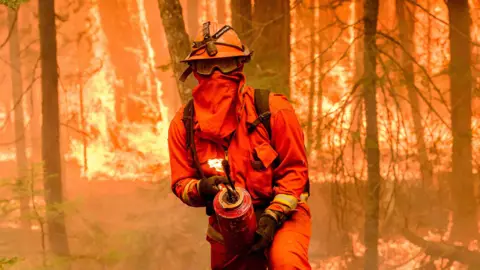 Agence France-Presse
Agence France-PresseThe headlines are very bleak – if action is not taken, the world’s temperature could rise by 3.1°C during this century, the UN says in a new report published today.
But how likely is that?
As is often the case with climate change and the science behind it, the answer is complex.
The UN report on the emissions gap suggests that if only “current policies” were implemented, the world could warm by up to 3.1°C.
This would be “catastrophic” for the world according to the United Nations, leading to significant increases in extreme weather events including heatwaves and floods.
Working outside with this level of warming would be extremely difficult if not impossible.
But this number is not entirely new, and must be seen in context.
UN temperature rise forecasts have remained unchanged over the past three years since countries gathered in Glasgow for the UN Climate Change Conference (COP26).
“Continuation of current policies is expected to limit global warming to a maximum of 3.1°C (range 1.9–3.8°C) over the century,” the new report says.
This figure is in line with projections from the latest IPCC report for 2021 which showed up to 3.6°C of warming this century at a higher level of emissions.
Today’s report says that if countries follow through on the promises they have already made in their carbon reduction plans, temperatures would rise by 2.6°C to 2.8°C.
If every country puts these plans into action and delivers on its existing net zero pledges, the Emissions Gap Report says the rise could be contained to 1.9°C.
Obviously, these colder scenarios are not guaranteed and let’s be clear, even a 1.9°C rise in temperature would be catastrophic. We have warmed our planet by 1.1°C so far and are feeling the effects on many levels, not least an increase in extreme weather and rising sea levels.
Promises and frustration
That these temperature forecasts have not really changed is one of the things that frustrates the UN – while countries made promises at COP27 and COP28, action on the ground has been very slow.
The UN report says that the Paris Agreement goals of keeping global temperatures below 2 degrees Celsius, while making efforts to stay below 1.5 degrees Celsius, are now in very serious danger.
However, it is important to keep in mind the timing of this report, which comes just a few weeks before political leaders gather in Azerbaijan for the United Nations Climate Change Conference (COP29).
Countries have agreed to put new carbon reduction plans on the table by next spring. These will cover the ten years until 2035.
Scientists know that if the emissions curve has not flattened by then, temperatures are likely to rise very stubbornly around or above 3 degrees Celsius.
This next set of plans, called Nationally Determined Contributions, has been described by the UN climate chief as among the most important documents produced this century.
This report should therefore be seen as part of a push for higher ambition on the part of world leaders.
 Agence France-Presse
Agence France-PresseWhat else is new in the report?
There are a number of new factors helping to increase emissions, according to the United Nations.
The aviation boom in 2023 saw carbon from flying rise by 19.5% compared to 2022, with passenger travel returning to levels close to pre-pandemic levels.
Road transport emissions have also risen, but there have been other major factors including the impact of climate change, which has led to rising temperatures forcing people to turn to more air conditioning.
“We are seeing or starting to see more serious impacts of climate change, so heatwaves have increased demand for energy to cool homes and offices,” said Dr. Anne Olhof, from the United Nations Environment Programme.
It has also affected hydropower generation, which has declined. What do you do next when it gets low? You turn to more coal.
Another element is the shift to electricity for vehicles and heating – the increasing number of electric vehicles and heat pumps is also increasing demand for energy, which is often met through fossil fuel sources.





